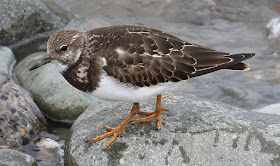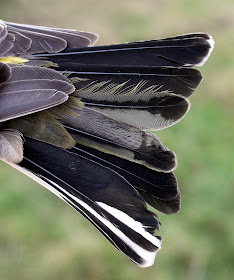It’s official, 2012 was the wettest year on record for the UK, not that birders, ringers or bird photographers needed the Met Office to tell them that.
Yesterday was no different, but in between the blustery showers I topped up the feeders Out Rawcliffe way, disturbing a gang of 20 or so Goldfinches in the process. If only the wind and rain would relent I could get a few nets up, have a half decent catch of birds and in-between times take a proper look around the site.
I found the two Chaffinch flocks again, about 60 one stubble field, and then 300+ on another field half a mile away. There were at least 4 Bramblings mixed in the bigger flock but hard to pin them down while the whole lot were so flighty, the wind induced movement of nearby trees, hedgerow and the leaf-strewn stubble making the birds nervous of the slightest disturbance.
Other birds in the area included pairs of Mistle Thrush and Kestrel, 30 + Skylark and 10+ Reed Bunting.
Indoors again today during the wind and rain, so as a post filler, I thought I’d recap some personal highlights of 2012 and include some favourite photographs of birds and places.
Last January Sue and I were in warm and sunny Lanzarote where Southern Grey Shrikes seemed especially numerous, often very close to the tourist beaches.
Southern Grey Shrike
Lanzarote
Spring came early in North West England, a feature being the movement north of Lesser Redpolls at the beginning of March when normally we would expect the phenomenon from mid-April onwards. After ringing over 90 of them during a warm spell of March weather, only 4 more were caught during April. I’d be happy to catch just stunning little Lesser Redpolls all year round. I’m still waiting to hear of a Belgium ringed one from September.
Lesser Redpoll
The month of May saw Sue and I visiting beautiful Menorca for the umpteenth time, seeing friends we have made over the years and heading for birding spots discovered through our travels.
Menorca
Bee Eater
The summer wasn’t too kind to birds, numerous nests and planned ringing sessions lost to the weather. Even the persistent Swallows fared badly. Sadly one place I visited for several years to monitor breeding Swallows decided they did not want the Swallows anymore, going to great lengths to keep the returning birds out of the farm buildings. Truly, this is becoming a sad, selfish world in which we live.
Barn Swallow
Barn Swallow
A result of the wet summer appeared to be poor fledging success, an example being a nest of three Sparrowhawks at Pilling where only one made it into the big wide world. Some birds spent time at nests which failed completely during the summery downpours e.g. a pair of Buzzards out on the mosses.
Sparrowhawk
Buzzard - Buteo buteo
Buzzard - Buteo buteo
A soggy Summer merged imperceptibly into an even rainier Autumn. Then before I knew it I was pitting my wits against returning Wheatears, catching more than a few via the mouth-watering meal worms.
Wheatear
Meal Worms
Wheatear
Autumn is finch time, a goal being to continue with the work on Chaffinches begun in 2010. Although numbers were down, the results I hoped proved interesting and informative to ringers and local birders alike - More On Chaffinches
Chaffinch
December brought the orange ones, the Bramblings from the east and north. Europe’s loss is our gain, so with luck and in a day or two we’ll meet again in 2013.
Brambling
Let’s take this opportunity to thank all those who follow or read Another Bird Blog on a regular, occasional or even accidental basis. Although many are scattered around the world they are friends indeed, and without their support and comments the blog would be nothing.
Happy New Year to all, and please visit again in 2013.
This week Another Bird Blog is linking to Weekly Top Shot and Paying-ready-attention-gallery.
This week Another Bird Blog is linking to Weekly Top Shot and Paying-ready-attention-gallery.
PS and don't forget, click on the pictures for a better qualty light box experience.


















































